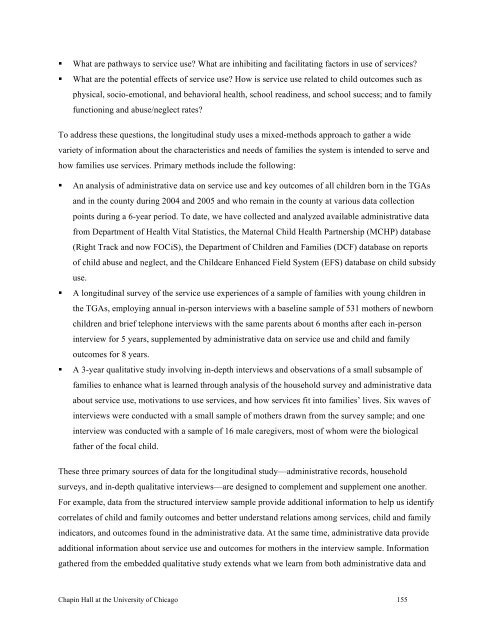2011 The Palm Beach County Family Study (Full Report)
2011 The Palm Beach County Family Study (Full Report)
2011 The Palm Beach County Family Study (Full Report)
- No tags were found...
You also want an ePaper? Increase the reach of your titles
YUMPU automatically turns print PDFs into web optimized ePapers that Google loves.
What are pathways to service use? What are inhibiting and facilitating factors in use of services?What are the potential effects of service use? How is service use related to child outcomes such asphysical, socio-emotional, and behavioral health, school readiness, and school success; and to familyfunctioning and abuse/neglect rates?To address these questions, the longitudinal study uses a mixed-methods approach to gather a widevariety of information about the characteristics and needs of families the system is intended to serve andhow families use services. Primary methods include the following:An analysis of administrative data on service use and key outcomes of all children born in the TGAsand in the county during 2004 and 2005 and who remain in the county at various data collectionpoints during a 6-year period. To date, we have collected and analyzed available administrative datafrom Department of Health Vital Statistics, the Maternal Child Health Partnership (MCHP) database(Right Track and now FOCiS), the Department of Children and Families (DCF) database on reportsof child abuse and neglect, and the Childcare Enhanced Field System (EFS) database on child subsidyuse.A longitudinal survey of the service use experiences of a sample of families with young children inthe TGAs, employing annual in-person interviews with a baseline sample of 531 mothers of newbornchildren and brief telephone interviews with the same parents about 6 months after each in-personinterview for 5 years, supplemented by administrative data on service use and child and familyoutcomes for 8 years.A 3-year qualitative study involving in-depth interviews and observations of a small subsample offamilies to enhance what is learned through analysis of the household survey and administrative dataabout service use, motivations to use services, and how services fit into families’ lives. Six waves ofinterviews were conducted with a small sample of mothers drawn from the survey sample; and oneinterview was conducted with a sample of 16 male caregivers, most of whom were the biologicalfather of the focal child.<strong>The</strong>se three primary sources of data for the longitudinal study—administrative records, householdsurveys, and in-depth qualitative interviews—are designed to complement and supplement one another.For example, data from the structured interview sample provide additional information to help us identifycorrelates of child and family outcomes and better understand relations among services, child and familyindicators, and outcomes found in the administrative data. At the same time, administrative data provideadditional information about service use and outcomes for mothers in the interview sample. Informationgathered from the embedded qualitative study extends what we learn from both administrative data andChapin Hall at the University of Chicago 155
















